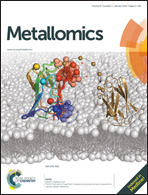Protein kinase CK2 regulates metal toxicity in neuronal cells
Abstract
Protein kinase CK2 is a pleiotropic tetrameric enzyme, regulating numerous biological processes from cell proliferation to stress response. This study demonstrates for the first time that CK2 is involved in the regulation of metal uptake and toxicity in neuronal cells. After the determination of inhibitory concentrations (IC50) for a range of metal salts (ZnSO4, Al(mal)3, CoCl2, CrO3, NaAsO2 and CaCl2) in Neuro-2a mouse neuroblastoma cells, the effect of CK2 on metal toxicity was investigated by three lines of experiments using CK2 inhibitors, metal ion specific fluorophores and siRNA-mediated knockdown of CK2 expression. The results showed that both CK2 inhibitors, 4,5,6,7-tetrabromobenzotriazole (TBB) and quinalizarin, markedly reduced the toxicity of Zn(II), Al(III), Co(II), Cr(VI) and As(III). Confocal microscopy imaging revealed that Zn(II) uptake was accompanied by the increase of intracellular Ca(II) in Neuro-2a cells treated with IC50 of ZnSO4 (240 μM), and such concurrent elevation of intracellular Zn(II) and Ca(II) was blocked by TBB and quinalizarin. The role of CK2 in metal uptake was further characterised using specific siRNA against each of the three subunits (CK2α, α′ and β) and the data demonstrate that CK2α′ is the prominent subunit regulating the metal toxicity. Finally, the role of CK2 in metal toxicity was found to be conserved in the distant species-Saccharomyces cerevisiae by employing the complete deletion mutants of CK2 (cka1Δ, cka2Δ, ckb1Δ and ckb2Δ). Taken together, these findings shed light on a new facet of CK2 functionality and provide a basis for further research on the regulation of Zn(II) and Ca(II) homeostasis by CK2.

- This article is part of the themed collection: Alzheimer's Research Month 2016

 Please wait while we load your content...
Please wait while we load your content...